Around Titicaca Lake
Titicaca lake really is a magical place on earth. At over 3800 mt of altitude, it’s the biggest lake in South America and the highest navigable lake in the world. It is also considered the birthplace of the great Inca culture, with Manco Capac, the first great ruler of Incas, raising from its water and departing from La Isla del Sol to found Cusco, the capital of the Inka Kingdom.
We spent few days around this glorious and stunning lake and it’s now time to share our experiences with you.

How to get there
There are 2 main access points to the Titicaca Lake: Puno in Peru and Copacabana in Bolivia. Either way you will have to catch a bus from Cusco (Peru) or LaPaz (Bolivia) to reach the shores of Titicaca.
Buses from Cusco leave for Puno at 8:00 AM or at 10 PM. (there are few companies covering the trip and the departure times vary 10-15 min with each other) The journey takes approximately 6 and a half hours and costs about 10-15€
From La Paz you can catch several buses per day for Copacabana and the price is about 5€. This journey is peculiar, as at one point you have to get off the bus, hop a boat to cross the strict and wait for the buses to be transported on the other shore with a special boat.
You can also book one of the touristic buses that cover the Cusco to La Paz journey an hop off and on in Puno or Copacabana, but they are usually more expensive.
Puno and Copacabana are connected with several buses per day and the trip doesn’t take longer than 4 hours, including border controls.
Puno
We stopped briefly in Puno, but we can swear the city itself has nothing memorable. The only touristic attractions are the tours departing from Puno bus station for the “floating island” and few Inka archaeological sites, which are interesting only if you have never been exposed to the Inka culture.
The so called “floating island” are actually quite interesting. They were built by the Uru people with reeds and the surely are a fascinating place. If you have some extra time, it’s definitely worth spending one day visiting them.
Copacabana
Most people in the world would think about Rio de Janeiro when they hear about Copacabana, but this small town in Bolivia is a little pearl itself. There is a majestic basilica for the Virgin Mary, as well as a Via Crucis built on “el calvario” mountain which prove the religious importance of the town for both Christians and Incas. The relaxed atmosphere makes it a popular tourist destination for Bolivian as well as foreigners.
Either you come from La Paz or from Peru, you’ll get off at the intersection of the 2 main streets of Copacabana. From there, within few blocks, you’ll find numerous hotels and hostels. Unless you are visiting in high season (Christmas and NYE) it’s not necessary to book in advance your accommodation, on the contrary you will be able to find very cheap prices. Just step in a couple of the hostals and ask for the best rate. We stayed in a nice hotel for 12€ a night, breakfast included and lake view from the room.
Copacabana is made of hotels and restaurants/bars. You will find plenty of vegetarian options as well. Mexican food seems to be a thing, empanadas are ubiquitous and pizzas a very popular option. But the very best food Copacabana has to offer is its local Trucha (trout). They fish it from the lake and cook it in dozens and dozens of variety. It really is delicious!
Isla del Sol & Isla de la Luna
From Copacabana you can hop on a boat and visit the two mystical islands that defined the Inka Culture. Unfortunately at the moment there is a conflict going on at la Isla del Sol, and it is not possible to visit the northern part of the island. You only have the option to book a tour for just la Isla del Sol for 20 bolivianos (2.5€) or for both islands for 40 bolivianos (5€). The boat ride from Copacabana to the islands takes about 1h30min.
La Isla de la Luna is a very small island with no potable water, however there are bout 60 families living on it. The main attraction (beside the gorgeous views of the Andes Cordillera) is the well preserved Temple of the Virgins. During Inka times the most talented and skilled virgins were living in this sacred building, developing further their knowledge.
La Isla del Sol is more populated, with 3 small villages and over 1500 people. They growth their own vegetables and they have drinking water. In fact the water comes from an holy Inka Spring, which is said to gift eternal youth. We drank from it and we haven’t aged noticeably in the past week.
On la Isla del sol there are few small temples, the first throne of Manco Capac (the founder of the Inka Kingdom) and some other ruins as well as original Inka Trails, still used nowadays. In particular, the original staircase that takes you from the beach to the holy spring is made of 1200 steps built by Inka in the early 1000s.
You can also spend the night at la Isla del Sol in one of the cute lodges, prices between 20€ to 35€.
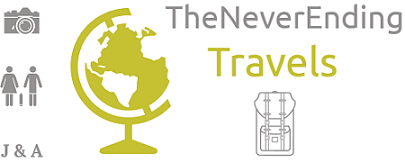
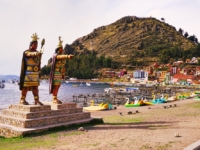
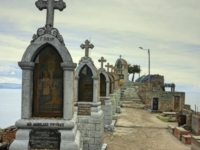
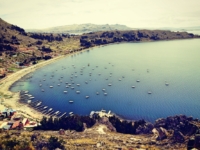
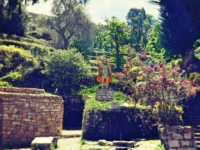
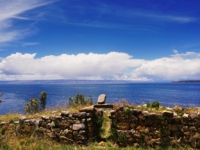
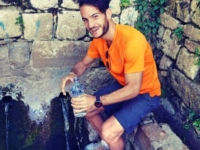
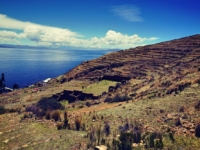
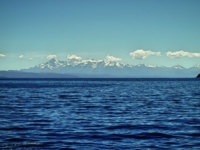
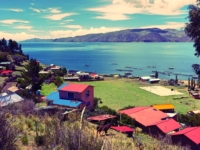
No Comments